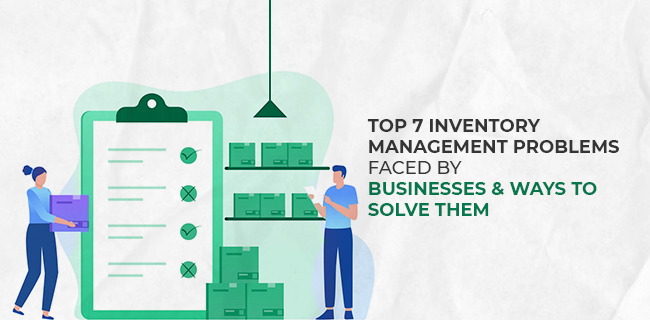
Navigating the Inventory Maze: Unpacking Common Business Inventory Problems and Their Strategic Solutions
Inventory, often viewed as a necessary asset, is a double-edged sword for businesses. While essential for meeting customer demand and facilitating production, it also represents a significant investment and a potential source of substantial operational and financial challenges. Effective inventory management is a delicate balancing act, and the slightest misstep can lead to a cascade of problems that impact profitability, customer satisfaction, and overall business sustainability. This article delves into the myriad of common business inventory problems, explores their far-reaching consequences, and outlines strategic solutions to transform inventory from a liability into a competitive advantage.
The Core Dilemma: Overstocking vs. Understocking
At the heart of most inventory problems lies the fundamental tension between having too much and having too little. Both scenarios, though seemingly opposite, are equally detrimental to a business.
Overstocking (Excess Inventory): This occurs when a business holds more inventory than it can sell or use within a reasonable timeframe. It’s often a result of overly optimistic sales forecasts, large-batch purchasing to secure discounts, or a fear of stockouts.
Understocking (Insufficient Inventory/Stockouts): This happens when a business runs out of a particular product or component, unable to meet immediate customer demand or production needs. It can stem from conservative forecasting, unexpected demand spikes, or unreliable supply chains.
Understanding these two core issues is the first step in addressing the broader spectrum of inventory challenges.
The Detrimental Effects of Overstocking
While a well-stocked warehouse might seem reassuring, excess inventory carries a hefty price tag and a host of hidden problems:
-
High Carrying Costs: This is the most direct financial drain. It includes:
- Storage Costs: Rent or depreciation of warehouse space, utilities, security, and maintenance.
- Insurance Costs: Higher inventory value means higher insurance premiums.
- Obsolescence: Products can become outdated, technologically inferior, or go out of fashion, rendering them unsellable or requiring steep discounts. This is particularly prevalent in electronics, fashion, and seasonal goods.
- Spoilage/Perishability: Food, pharmaceuticals, and other perishable goods have a limited shelf life, leading to direct financial losses if not sold in time.
- Damage: The longer items sit in a warehouse, the higher the risk of being damaged by handling, environmental factors (humidity, temperature), or pests.
- Shrinkage/Theft: More inventory means more opportunities for items to be lost, misplaced, or stolen.
-
Cash Flow Drain: Inventory is capital tied up. Every dollar spent on excess stock is a dollar that cannot be used for other critical business functions like marketing, R&D, debt repayment, or expansion. This can severely restrict a company’s liquidity and financial flexibility.
-
Opportunity Cost: The capital tied up in excess inventory could have been invested elsewhere to generate a higher return. This "missed opportunity" is a significant, though often invisible, cost.
-
Reduced Flexibility: Large inventories can make a company less agile. It becomes harder to adapt to changes in market demand, introduce new product lines, or pivot business strategies when significant capital is locked in old stock.
-
Increased Labor Costs: Managing, moving, and tracking excess inventory requires more labor, from warehouse staff to inventory managers, adding to operational expenses.
The Crippling Consequences of Understocking
Conversely, having too little inventory can be equally, if not more, damaging, especially in terms of customer perception and lost revenue:
-
Lost Sales and Revenue: The most immediate impact of a stockout is the inability to fulfill customer orders, leading directly to lost sales and revenue. Customers often take their business elsewhere, sometimes permanently.
-
Customer Dissatisfaction and Loyalty Erosion: Repeated stockouts frustrate customers. It signals unreliability and can damage a brand’s reputation, leading to a loss of trust and long-term customer loyalty. In today’s competitive landscape, customers have countless alternatives.
-
Production Delays and Halt: For manufacturers, a shortage of raw materials or components can bring production lines to a standstill, leading to costly downtime, missed deadlines, and contractual penalties.
-
Expedited Shipping Costs: To mitigate the damage of a stockout, businesses often resort to rush orders and expedited shipping, incurring significantly higher transportation costs that eat into profit margins.
-
Damage to Brand Reputation: A company consistently unable to meet demand can be perceived as disorganized, inefficient, or simply unreliable, tarnishing its brand image and making it harder to attract new customers.
Root Causes of Inventory Problems
Understanding the "why" behind these issues is crucial for developing effective solutions. Common root causes include:
-
Inaccurate Demand Forecasting: This is perhaps the most significant culprit. Poor historical data analysis, neglecting seasonal trends, ignoring market shifts, or simply lacking sophisticated forecasting tools can lead to major discrepancies between predicted and actual demand.
-
Lack of Visibility and Data Inaccuracy: Many businesses struggle with knowing exactly what inventory they have, where it is, and its condition. Manual tracking systems, infrequent audits, and disconnected data systems lead to errors, miscounts, and a general lack of real-time insight.
-
Inefficient Warehouse Operations: Poor warehouse layout, disorganized storage, inefficient picking and packing processes, and inadequate staff training can contribute to inventory damage, loss, and delays, making it harder to track and manage stock.
-
Long and Variable Lead Times: If suppliers have long lead times or their delivery times are inconsistent, businesses are forced to hold more safety stock to avoid stockouts, increasing the risk of overstocking if demand falls.
-
Poor Supplier Relationship Management: A lack of communication or weak relationships with suppliers can lead to miscommunications about order quantities, delivery schedules, and quality issues, all impacting inventory levels.
-
Lack of Integrated Systems: Disjointed systems for sales, purchasing, warehousing, and finance prevent a holistic view of inventory, leading to silos of information and inefficient decision-making.
-
Human Error: Mistakes in data entry, counting, picking, packing, or receiving goods are inevitable and can accumulate to significant inventory inaccuracies.
-
Sudden Market Shifts and Disruptions: Unforeseen events like economic downturns, natural disasters, pandemics (e.g., COVID-19), or geopolitical conflicts can dramatically alter demand patterns and supply chain reliability, catching businesses off guard.
Strategic Solutions for Effective Inventory Management
Addressing inventory problems requires a multi-faceted approach, integrating technology, process optimization, and strategic planning.
-
Invest in Robust Inventory Management Systems (IMS) / Enterprise Resource Planning (ERP):
- Centralized Data: These systems provide a single source of truth for all inventory-related data, from procurement to sales.
- Real-time Visibility: Track inventory levels, locations, and movements in real-time, significantly reducing manual errors and improving accuracy.
- Automation: Automate tasks like reorder point calculations, purchase order generation, and stock transfers, streamlining operations.
- Integration: Link with sales, purchasing, accounting, and warehouse management systems for a holistic view of the business.
-
Improve Demand Forecasting Accuracy:
- Utilize Advanced Analytics: Employ statistical models, machine learning, and AI to analyze historical sales data, seasonal trends, promotions, and external market factors.
- Collaborative Planning, Forecasting, and Replenishment (CPFR): Work closely with customers and suppliers to share demand forecasts and production plans, improving accuracy across the supply chain.
- Scenario Planning: Develop multiple forecasts based on different market conditions to prepare for various eventualities.
-
Implement Inventory Classification and Prioritization (ABC Analysis):
- Categorize inventory items based on their value and sales volume.
- A-items: High-value, high-volume (e.g., top 20% of items accounting for 80% of sales). Require tight control, frequent review, and accurate forecasting.
- B-items: Medium-value, medium-volume. Moderate control.
- C-items: Low-value, low-volume (e.g., bottom 50% of items accounting for 5% of sales). Simpler control, often managed with larger batch orders.
This allows businesses to focus their efforts where they yield the greatest return.
-
Optimize Order Quantities and Reorder Points:
- Economic Order Quantity (EOQ): Calculate the optimal order quantity that minimizes total inventory costs (carrying costs + ordering costs).
- Safety Stock: Determine an appropriate level of safety stock to guard against unexpected demand spikes or supply delays, balancing the risk of stockouts with carrying costs.
- Reorder Points: Establish clear reorder points that trigger new purchase orders when inventory levels fall to a predetermined threshold.
-
Strengthen Supplier Relationships:
- Collaborate and Communicate: Foster strong, transparent relationships with suppliers to ensure reliable delivery, negotiate favorable terms, and share demand forecasts.
- Vendor-Managed Inventory (VMI): Allow key suppliers to manage inventory levels for their products in your warehouse, reducing your burden and often improving stock availability.
- Diversify Suppliers: Reduce reliance on a single supplier to mitigate risks associated with disruptions.
-
Enhance Warehouse and Logistics Operations:
- Cycle Counting: Implement regular, small-scale inventory counts throughout the year instead of annual physical counts. This improves accuracy, identifies discrepancies faster, and causes less disruption.
- Efficient Layout and Storage: Optimize warehouse layout for faster picking, packing, and receiving, reducing damage and increasing efficiency.
- Barcode and RFID Technology: Utilize these technologies for rapid and accurate inventory tracking, eliminating manual errors.
- Cross-Docking: Minimize storage time by moving goods directly from inbound to outbound logistics, especially for high-turnover items.
-
Embrace Lean Inventory Principles (e.g., Just-In-Time – JIT):
- JIT aims to receive goods only as they are needed for production or sale, minimizing inventory holding costs. While highly effective, it requires extremely reliable demand forecasting and supply chains, making it less suitable for businesses with high demand variability or unreliable suppliers.
- Even if full JIT isn’t feasible, adopting its core philosophy of waste reduction and continuous improvement can significantly streamline inventory processes.
-
Regular Audits and Performance Metrics:
- Continuously monitor key performance indicators (KPIs) such as inventory turnover rate, days sales of inventory, stockout rate, order fulfillment rate, and carrying costs.
- Regularly audit inventory processes to identify bottlenecks and areas for improvement.
Building Resilience in Inventory Management
The recent global disruptions have underscored the importance of resilience. Beyond optimization, businesses must build robust inventory strategies that can withstand shocks:
- Supply Chain Diversification: Having alternative suppliers in different geographical regions can buffer against localized disruptions.
- Buffer Stock for Critical Items: While lean is good, strategic buffer stock for essential, long lead-time, or highly volatile items can be a lifeline during crises.
- Scenario Planning and Contingency Plans: Regularly assess potential risks (e.g., natural disasters, geopolitical events, supplier bankruptcy) and develop plans to mitigate their impact on inventory.
- Technological Agility: Invest in flexible inventory systems that can adapt to changing business needs and integrate new technologies quickly.
Conclusion
Inventory management is far more than just counting stock; it’s a strategic imperative that directly impacts a business’s financial health, operational efficiency, and customer relationships. The challenges of overstocking and understocking, driven by a myriad of root causes from inaccurate forecasting to supply chain disruptions, demand sophisticated and proactive solutions. By leveraging technology, refining processes, fostering strong supplier relationships, and embracing a culture of continuous improvement, businesses can transform their inventory from a potential problem into a powerful asset. Navigating the inventory maze successfully requires a holistic understanding of its complexities and a commitment to strategic optimization, ensuring that the right products are available at the right time, in the right quantity, at the lowest possible cost.

